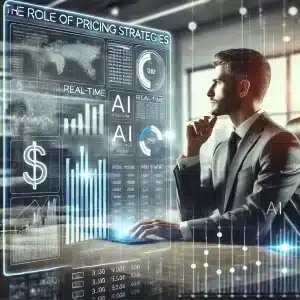The advent of AI has revolutionized numerous facets of business, none more so than pricing strategies. With artificial intelligence (AI) tools, companies can now optimize prices dynamically and efficiently, ensuring competitiveness and maximizing revenue. This article delves deep into AI-powered pricing, exploring its benefits, key use cases, and how businesses can implement this technology to stay ahead in the market.
How Can AI Optimize Pricing Strategies in Real-Time?
What is AI-Powered Pricing?
AI-powered pricing is an advanced pricing strategy that leverages artificial intelligence to set prices dynamically based on various factors, including market demand, competitor prices, and customer behavior. By using machine learning algorithms, businesses can continuously adjust and optimize their pricing strategies in real-time. This approach goes beyond traditional pricing methods by incorporating predictive analytics and real-time data, enabling companies to make data-driven pricing decisions that align with current market trends.
How Does AI Analyze Competitor Prices?
One of the critical components of AI-powered pricing is its ability to analyze competitor prices continuously. AI algorithms can scrape vast amounts of data from competitor websites, market reports, and other relevant sources to provide up-to-date insights into how competitors are pricing similar products or services. This dynamic pricing strategy allows businesses to remain competitive by adjusting their prices promptly in response to market changes, ensuring that they attract and retain customers while maximizing profit margins.
What Role Do AI Algorithms Play in Optimization?
AI algorithms are the backbone of pricing optimization. These algorithms analyze extensive datasets, identifying patterns and trends that inform optimal pricing decisions. Machine learning models can predict customer willingness to pay, enabling businesses to set prices that maximize revenue without deterring potential buyers. Additionally, AI techniques such as generative AI can simulate various pricing scenarios to determine the best strategy under different market conditions, ensuring that prices are always optimized for maximum profitability.
What Are The Benefits of Implementing AI-Powered Pricing?
How Can AI Maximize Revenue Through Price Optimization?
AI-powered pricing can significantly boost revenue by ensuring that prices are continuously optimized to reflect current market dynamics. By analyzing customer data and market demand in real-time, AI can set prices that maximize sales and profit margins. This level of optimization is virtually impossible to achieve with traditional pricing methods, which often rely on static pricing models and outdated data. AI facilitates a more responsive and flexible pricing strategy, allowing businesses to capitalize on market opportunities as they emerge.
What Impact Does AI Have on Customer Behavior and Satisfaction?
AI-powered pricing not only benefits businesses but also enhances customer satisfaction. By personalizing pricing based on customer behavior and preferences, AI can offer tailored pricing that aligns with individual customer expectations. This personalized approach increases customer loyalty and the perceived value of products or services. Furthermore, by ensuring competitive pricing, AI helps companies build trust and credibility with their customers, ultimately leading to higher customer retention and satisfaction rates.
How Can AI Leverage Large Amounts of Data for Better Decision Making?
AI’s ability to process and analyze large amounts of data is a game-changer for pricing strategies. By leveraging customer data, market trends, and competitive pricing information, AI can make well-informed pricing decisions that would be impossible to achieve manually. Advanced analytics enable businesses to understand complex market dynamics and customer preferences, providing a solid foundation for setting optimal prices. This data-driven approach results in more accurate pricing models and better overall pricing management.
What Are the Key Use Cases of AI in Pricing Strategies?
How Do Companies Use AI For Dynamic Pricing?
Companies across various industries use AI-driven pricing strategies to stay competitive and increase profitability. For instance, e-commerce platforms use AI to adjust prices in real-time based on factors such as inventory levels, competitor prices, and customer demand. This dynamic pricing ensures that products are priced optimally, maximizing sales and revenue. In the travel industry, airlines and hotels use AI-powered systems to adjust prices based on booking trends and seasonal demand, ensuring they remain competitive while optimizing occupancy rates.
Can AI Help in Predictive Analytics for Pricing?
Predictive analytics is one of the most powerful applications of AI in pricing strategies. By analyzing historical sales data, customer behavior, and market trends, predictive analytics can forecast future demand and price sensitivity. This enables businesses to set prices that not only reflect current market conditions but also anticipate future trends. AI uses these insights to develop pricing models that optimize long-term profitability, helping companies remain agile and responsive in a constantly changing market.
What Are Some Real-World Examples of AI-Driven Pricing?
Several companies have successfully implemented AI-driven pricing strategies with remarkable outcomes. Amazon, for example, uses AI algorithms to adjust prices for millions of products in real-time, ensuring that they remain competitive while maximizing profits. Similarly, Uber employs AI to set dynamic prices for its ride-hailing services, adjusting fares based on demand, traffic conditions, and other factors. These real-world examples demonstrate the transformative impact of AI on pricing strategies, highlighting the potential for substantial revenue gains and improved customer experiences.
How to Implement AI-Powered Pricing Strategies in Your Business?
What Steps Are Involved in Setting Up AI Pricing Software?
Implementing AI-powered pricing software involves several critical steps. First, businesses must identify their pricing objectives and the specific challenges they aim to address with AI. Next, they need to collect and preprocess relevant data, including sales figures, customer behavior data, and competitive pricing information. Once the data is ready, companies can select and implement appropriate AI algorithms and machine learning models. Finally, continuous monitoring and adjustment are essential to ensure the AI system continues to deliver optimal pricing decisions as market conditions evolve.
How to Integrate Machine Learning for Optimal Pricing Decisions?
Integrating machine learning into pricing strategies involves building and training models that can analyze data and automate pricing decisions. Businesses must first define the features and variables that influence pricing, such as customer demographics, purchase history, and external market conditions. Machine learning algorithms can then be trained on historical data to identify patterns and optimize pricing strategies. Continuous learning and iteration are crucial, as these models must be regularly updated with new data to maintain their accuracy and effectiveness.
What Challenges Might You Face While Implementing AI Solutions?
Implementing AI-powered pricing solutions can present several challenges. Data quality and availability are significant hurdles, as accurate and comprehensive data is essential for effective AI training. Additionally, integrating AI systems with existing business processes and IT infrastructure can be complex and time-consuming. Another challenge is ensuring that AI-driven pricing decisions align with broader business objectives and do not jeopardize customer relationships. Overcoming these challenges requires careful planning, robust data management, and a clear understanding of both the technology and its business implications.
How Can Predictive Analytics Revolutionize Pricing Strategies?
What Role Does Predictive Analytics Play in AI-Powered Pricing?
Predictive analytics plays a pivotal role in AI-powered pricing by providing insights into future market trends and customer behavior. By analyzing historical data and identifying patterns, predictive analytics can forecast demand, price sensitivity, and competitive dynamics. These forecasts enable businesses to set optimal prices that maximize revenue and profitability over the long term. Predictive analytics also helps companies stay ahead of the curve, proactively adjusting their pricing strategies in anticipation of market shifts and customer preferences.
How Can AI Predict Future Customer Behavior and Trends?
AI leverages machine learning algorithms to predict future customer behavior and market trends with remarkable accuracy. By analyzing past purchase data, browsing patterns, and external factors such as economic indicators, AI can identify emerging trends and forecast future demand. These predictions allow businesses to set prices that reflect upcoming market conditions, ensuring they remain competitive and responsive. AI’s ability to predict customer behavior also enables more personalized pricing strategies, enhancing customer satisfaction and loyalty.
What Tools Are Available for Predictive Analytics in Pricing?
Several tools are available to support predictive analytics in pricing. Advanced AI platforms offer comprehensive solutions that integrate data collection, analysis, and decision-making processes. Popular tools include AI-powered analytics platforms like SAS, IBM Watson, and Google Cloud AI, which provide robust capabilities for data analysis and predictive modeling. These tools enable businesses to leverage AI for pricing optimization, ensuring they can set competitive and profitable prices in real-time.





